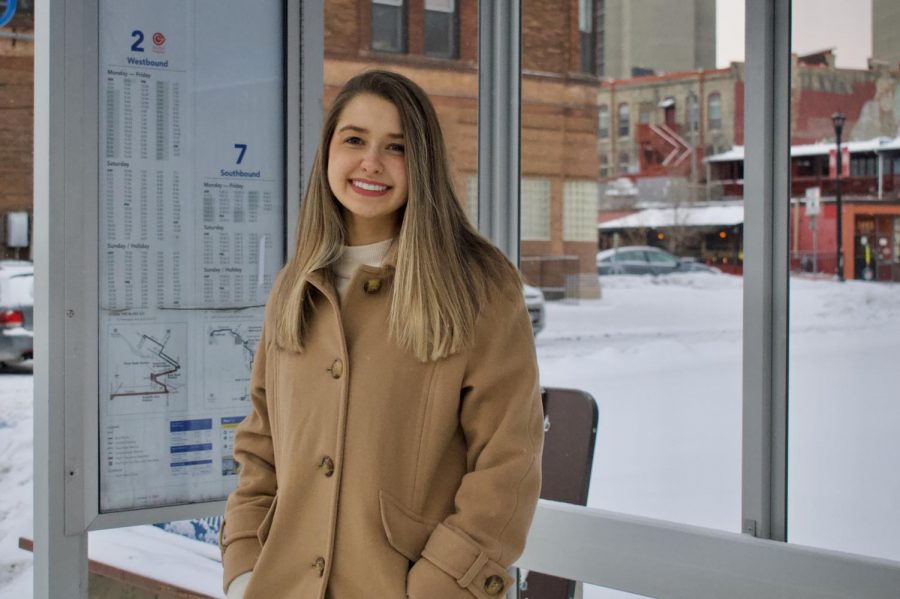One day when Ania McDonnell was taking the light rail to an internship as a student at Hamline University, she said she was followed after she got off the platform.
Throughout college and into graduate school at the University of Minnesota, McDonnell continued having conversations with other women about their experiences on public transit. One woman she talked to was kissed on the cheek by a stranger, and many others had their own stories about times they felt unsafe.
“I actually would be curious if there’s a woman who hasn’t experienced some type of harassment on public transportation,” McDonnell said. “It’s definitely something that I think not everyone understands.”
For her master’s thesis, McDonnell researched how people experience transit differently, and how the design of city transportation plans accommodate their needs — or not.
Last year, she analyzed the 10-year transportation plans of several cities around Minnesota, including Minneapolis, Bloomington, Little Canada and Centerville. Looking for specific keywords related to gender, as well as how each comprehensive plan accounted for inclusivity, she found almost none of these city plans explicitly addressed how people experience or use transportation differently.
Since then, her research has caught the attention of city planners, especially in light of Transit Equity Day on Feb. 4.
Based on her research, and the research of others at the University, McDonnell found that women often have different transportation needs and face additional challenges compared to men. On average, women make more trips than men, have greater security concerns in dark or deserted transit areas and travel during off-peak hours for part-time jobs, like in the caregiving sector. LGBTQ people also are more likely to experience harassment and assault on transit.
A system rooted in racism
Dr. Yingling Fan, a professor of urban and regional planning at the University, said public transportation systems in the United States are rooted in a larger context of systemic racism, which greatly affects how people access and use public transportation today.
Fan said a high-quality, equitable transportation system needs to be accessible, affordable and designed with and for the communities who use it.
In the Twin Cities, the thriving Rondo community was destroyed in order to make way for the construction of the 1-94 highway in the 1950s and ‘60s, for instance, resulting in the displacement of hundreds of Black families and the destruction of hundreds of businesses.
Fan said the cultivation of a society that is reliant on private transportation, like cars, contributes to existing inequalities.
“Whenever you have a kind of default mode for transportation, then you actually expect to create an underclass,” Fan said. “When you have an entire city kind of reconstructed to serve people who use automobiles, then certainly people who don’t use automobiles will be disadvantaged.”
She emphasized the need to properly invest in public transportation, especially as communities of color make up 60% of those who use public transportation to get around.
Navigating lengthy commutes
Fan’s research has also shown that women typically have a shorter commute time than men but make more stops, possibly related to child care, grocery shopping and other errands, whereas men typically use transportation to commute to one location.
McDonnell said public transportation has not been designed to address these needs. Oftentimes, it is challenging to make multiple trips by bus or light rail, and usually results in long wait times and lengthy commutes.
For those who live in suburbs these barriers are even more pronounced.
For someone living in north Minneapolis who works at the Mall of America, for instance, there is no direct public transportation connecting those two sites, Fan said. This means people would have to consider taking multiple modes of transportation, like taking the bus to a light rail station, and factor in wait times, commutes, safety and the reliability of public transportation.
“I think more innovation will be very important,” she said. “We cannot continue to do business as usual.”
‘Redefining’ public transit
Rather than simply investing in more buses, Fan said city planners have to redefine what public transit is and looks like. In the future, this could be like investing in car-pooling or pick up services like Uber that are operated by a public transit service.
In her thesis, McDonnell lists a series of recommendations for city planners moving forward. Some of her suggestions include collecting city-level transportation data by gender and providing transportation vouchers to people receiving Temporary Assistance for Needy Families.
“It is important to include community voices, because while many of us involved in the transportation field bring tremendous technical expertise to the table, the folks who are most immediately impacted by our decisions are the people who live in the neighborhoods,” said Gloria Jeff, an experienced transportation executive and urban planner who heads MnDOT’s Metro District Livability Initiative. “Focusing on transit is important … [it’s] not just how you get from point A to point B, but also how transportation provides you with access to a variety of other opportunities.”














